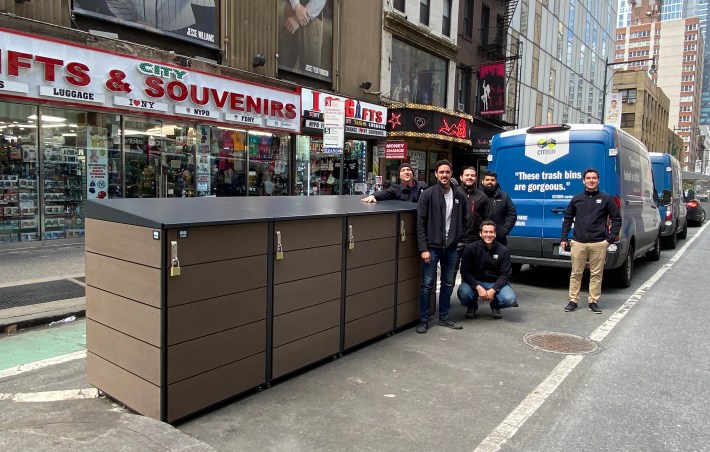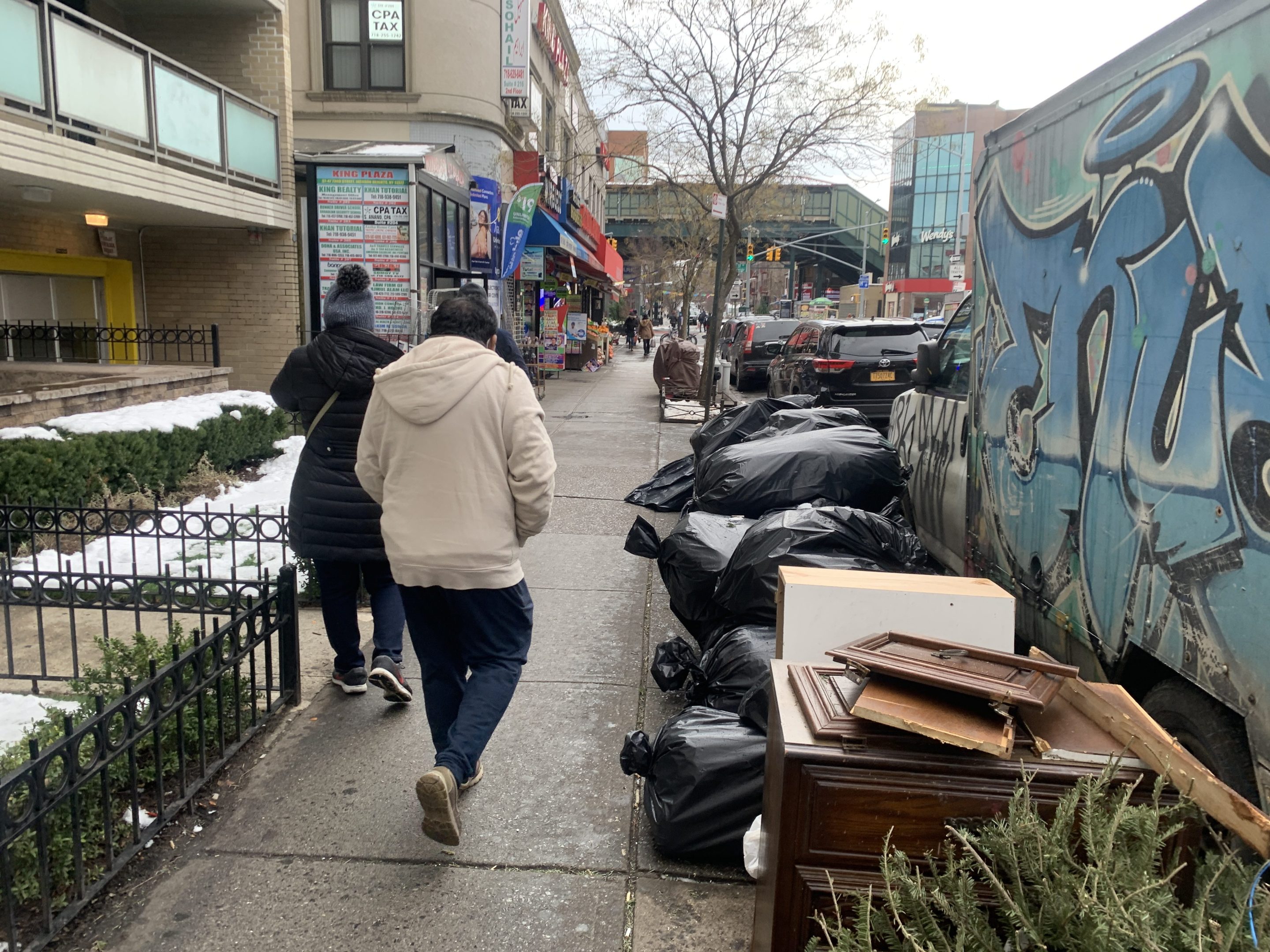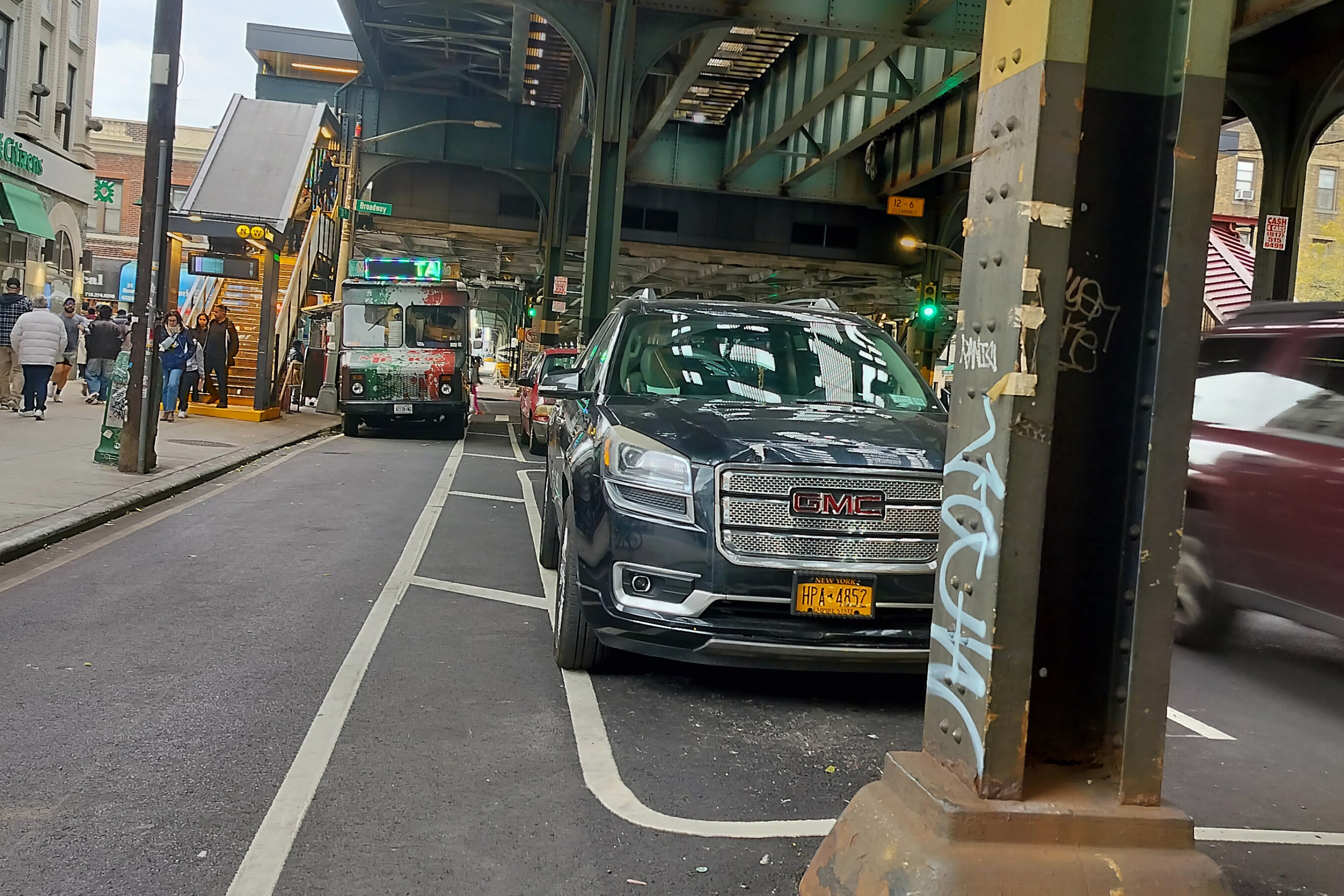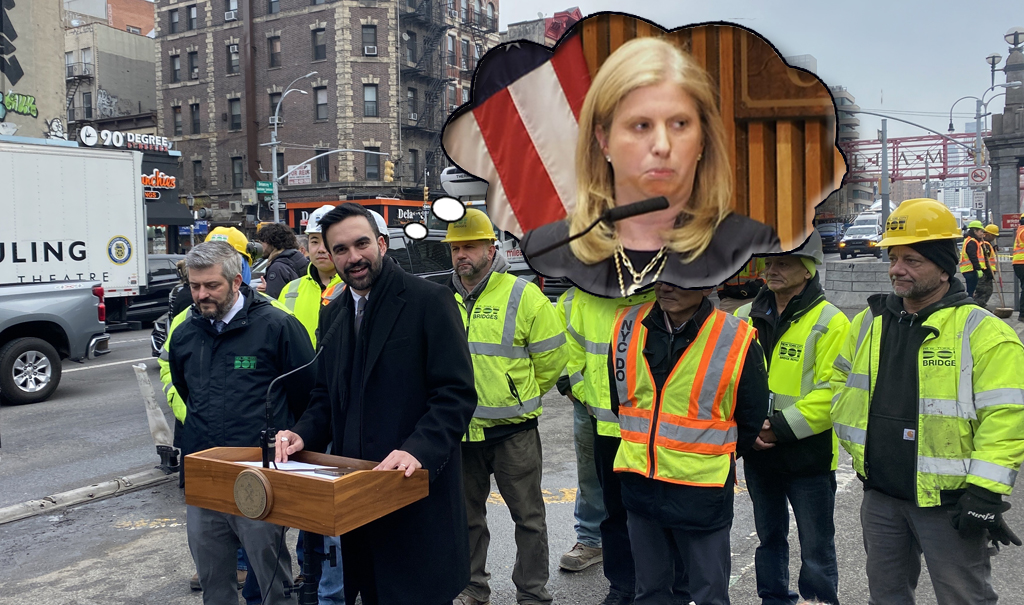For some, it's a pail imitation.
As the City Council gears up to discuss the mayor's executive budget for the Sanitation Department on Tuesday, advocates are warning that the city's "Clean Curbs" pilot is too small and unambitious to be scalable citywide — a Potemkin project with little money behind it.
The pilot — a $1.3-million initiative that was announced in 2020 with great fanfare, but slow to get off the ground — seeks to shave the city’s "5 o’clock shadow" of leaky, stinking black plastic garbage bags that appear each afternoon on sidewalks and block pedestrians in public space — not to mention that they put New York decades behind the sanitation efforts of cities around the world, which have devised a variety of safe and efficient ways of storing their trash before collection, thank you.
The pilot, which has a commercial and a residential component, recently debuted with two, four-bin trash enclosures in Times Square, paid for by the Times Square Alliance, the area's business improvement district. At a press conference last month unveiling the enclosures, Mayor Adams promised that that the project would be "scalable" and announced that it would launch in all five boroughs.

The next iteration — the residential component — will containerize the garbage of a still-undetermined number of apartment buildings in the curb lane of a single block in Manhattan. Starting on June 2, the city will begin installing nine curb-lane garbage enclosures for use by the buildings (they will take up the equivalent of what drivers believe is six parking spaces). The one-year pilot will cost $462,750 for the design, fabrication, installation and maintenance of the enclosures as well as the conducting of "stakeholder engagement" and a report on the outcome. The Brooklyn-based, woman-owned firm CITIBIN won the contract, which the city solicited using an expedited process for "small purchases."
For some advocates, the limited scope and scale of both parts of Clean Curbs — basically, the piloting of off-the-shelf storage sheds for bags — hampers the city's goals because it does not require the total rethinking of garbage-collection methods, which is what the city ultimately needs.
"There is so much pressure to do things quickly and would be better to spend a little more time designing the pilot and aims," said Clare Miflin, the founder of the Center for Zero Waste Design, which advocates for a comprehensive solution to the city's trash problem. Miflin said that DSNY should consider a much-more-ambitious scheme: adding lifting mechanisms — a long-used and not-too-expensive technology — to rear-loading trucks, which would allow Clean Curbs enclosures to be bigger.
Larger bins, Miflin argued, would make trash pickup quicker and more space efficient while bettering labor condition for "New York's Strongest," who could still work two per truck (as they do now) without having to lift five tons of heavy bags per shift. The wheeled bins could be brought straight to trucks from near buildings and wouldn't necessarily require curbside enclosures (although street-safety advocates like the curbside idea because the enclosures take up space that would be used for free car storage).
"Really, the next [solid waste management plan] needs to be comprehensive and consider everything from collection logistics to final disposal, and the pilots should serve those larger aims of how can the whole system be improved so there are no bags of trash full of food waste and attracting rats and causing litter. That is what our putwastetowork.org advocacy campaign is all about."
Others questioned whether a limited pilot could tell the city very much about how it is working.
"How can you tell the impact of such a project if it's confined to one city block?" asked Janet Liff, a member of Manhattan Community Board 2 in Greenwich Village, an area with a pronounced rat problem. "If you do a pilot, it should be in a nine-block area; then you could see its effects on what we struggle with, especially vis-a-vis the rat population."
The criticisms are important, because earlier Sanitation pilots — in particular, the department's vaunted "Brown Bins" composting project — foundered for similar reasons of a limited scope. That optional program, which reached only 10,834 addresses in seven community boards, had spotty uptake, and Adams decided to halt its expansion, cutting its budget by almost $91 million over the next five years. The cuts prompted an immediate outcry and legislation to enshrine its goals.
Also, the $1.3 million the city is spending on the Clean Curbs pilots is very little — a rounding error in an annual city budget of $98 billion and even in DSNY's portion of it. (The mayor’s FY 23 Executive Budget allocates $1.83 billion to DSNY, the department said.) By way of comparison, even a recent (and temporary!) Department of Transportation education program involving billboards admonishing drivers to slow down cost $4 million. DSNY faced criticism earlier when it allotted a pokey $100,000 for five grants worth up to $20,000 each in a bid to stoke participation in the Clean Curbs commercial pilot.
But DSNY defended its small expenditure.
"The $1.3-million Clean Curbs pilot is exactly that, a pilot that will allow us to see what works and what does not work," said DSNY spokesman Vincent Gragnani. "We don’t know at this point what each of those pilots will look like, but we know that starting with different types of residential and commercial containers in each of the five boroughs will allow us to see, in a variety of settings, what is most scalable. In other words, if this works, we will work with advocates to discuss next steps."
For its part, CITIBIN, which designs its rat-proof enclosures out of aluminum clad in a bamboo-composite material used in decking, is raring to go.
"Ever since I heard about Clean Curbs, I knew CITIBIN should be involved," said CITIBIN's founder and CEO Liz Picarazzi. "The program is about containerizing waste, and that's exactly what CITIBIN does. We know a lot about New York City trash and rats from making trash enclosures for a decade. The pilot is just as much about people as it is product. How will the people involved — sanitation workers, supers, property managers, residents — feel about putting trash in bins versus on the sidewalk? We're excited to be a part of the experiment!"
The residential pilot is likely to happen in the Chelsea-Midtown Council District of Erik Bottcher, who has positioned himself as a leader on trash issues. It is also where the local pedestrian-advocacy group CHEKPEDS created a guerrilla-style trash enclosure in a parking space in 2020 (only to be told by the city to cease and desist) — meaning, the residential enclosure has a ready-made constituency and defender in the area. Both declined comment.






